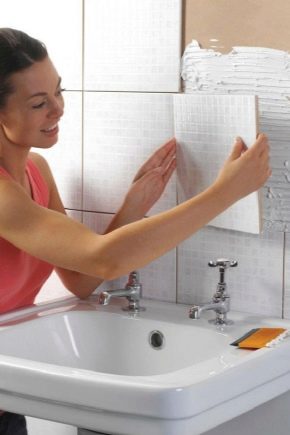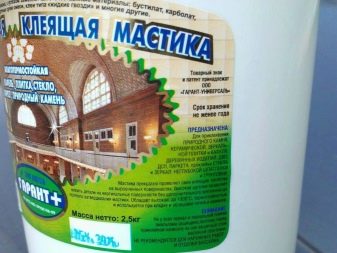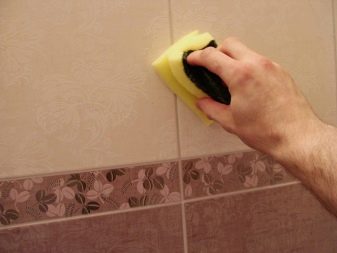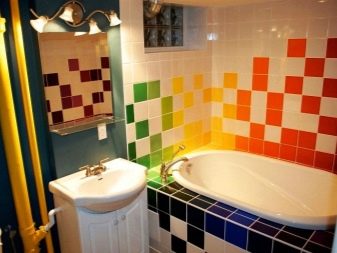How to glue the tiles in the bathroom if they fell off?

In almost every home, the bathroom is finished with ceramic tiles on the walls and tiles on the floor. Sometimes, of course, there are options with a putty for painting and linoleum, but these are extremely impractical options, and any owner tries to fix this as soon as possible, replacing everything that is possible with tiles. But sometimes the tiles fall off and the room loses its appearance. But there is nothing irreparable, there is a way out, it will be discussed in the article.
Reasons for peeling tiles
Before fixing a defect, it is necessary to understand the cause and nature of the defect. This can be roughly divided into three categories: poor-quality repairs, poor-quality materials, service life.
By substandard or unfair performance of work, we mean a violation of the tile laying technology. For example, the master glued the tiles not to the comb, but to the points, and in less quantity than required. With dots that are evenly distributed, practically nothing will happen, but sometimes craftsmen are chasing money, doing everything quickly and without dedication. A tile glued to 2 - 3 points will fall off after some time, especially if there was a mechanical impact on it. Such a defect is easily calculated by tapping; there should be no voids in the sound.


If the tile fell off, and you can see that it was glued to the comb (one-level continuous glue under it), and the glue remained on the tile, most likely this is due to the fact that an inexperienced master, experienced ones do not make such a childish mistake, glued the tile to gypsum material (putty). Putty and glue: both tiled and gypsum plasterboard, do not have adhesion at all, the question is: it will fall off or not, it is not worth it. Will fall off, the question is how quickly. To eliminate this defect, unfortunately, you will have to remove the product until there is a wall under it or the putty disappears.
Judging by the statistics, it is better to remove, in principle, the entire wall of the tile and clean it of gypsum materials, and then re-glue it in compliance with the technology.


Low-quality materials are mainly understood as tile adhesive with an expired shelf life, with incorrect storage conditions or an incorrect ratio of components. Such glue will last much shorter, if any. Such a defect is eliminated by removing the entire wall and eliminating the problematic material.
In addition, sometimes it happens that the tile itself fails for various reasons. Many people make the space near the fireplace, boiler or other heating systems with a high operating temperature from ordinary tiles and heat-resistant tile adhesive. The glue withstands the temperature load, but the tile begins to crack, so it is worth paying attention to this factor when buying.


Life time. It is no secret that any material has its own service life, after which the risk of defects increases several times.
There is only one solution here - renewal by repairing and replacing both material and tiles, with preliminary cleaning of the surface.
Preparation for tiling work
After dismantling the tiles in the bathroom, including the floor one, it is recommended to make the floor waterproofing, which overlaps the walls, the overlap is from 20 to 30 cm.After that, the wall surface, on which there is no waterproofing, should go through a deep penetration primer.Then it is necessary to check the floor level, determine the slope, if there is a drain, and, if necessary, bring the floor to the desired level while observing the plane. The same applies to the walls, only taking into account the fact that large (more than 2 cm) areas are greased with tile glue.
After that, it is necessary to check the materials, their expiration date and quantity, so that the work turns out immediately, and does not run out due to a lack of materials.
As for wooden houses and structures, the tiles are laid on special compounds like elastic glue or liquid nails.


Selection of the necessary tools and materials.
To work on tiles, you don't need as many tools as you might think:
- notched spatula, cap (10 cm) and ordinary (25 cm);
- a hammer with a rubber top (mallet);
- a pair of buckets (for solution and water);
- rags;
- paint brush;
- crosses and other fixing materials;
- fugue.

As for the purchase of a new tile, it all depends on the budget, desire and safety of the previous tile, which can be cleaned of glue. In any case, the old tile will have chips and cracks from falls or physical impact, so it will have to be replaced. But the restoration of tiled masonry is the same method, which is the same for both the old tile (provided it has been cleaned) and for the new tile.
The second thing that is mandatory for buying materials is an adhesive component.
Adhesion to the surface also depends on its type; for different types of surface material, there are different types of adhesive component.
- Bulk materials. Or ordinary tile glue. One of the most popular materials for this type of work. There are several varieties, differing in composition, affecting the fixation and setting speed, frost resistance.
- Liquid Nails. Elastic, easy to use, fast option. But with this type of material, single fallen off tiles can be glued, since it glues, but does not cover the surface with a protective layer.


- Mastics. Practically not used in civil engineering. Highly resistant to compression and deformation. They are used in the mining industry and industries with unstable seismic conditions.
- Cement mortar. Very high strength, low elasticity. It is mainly used in outdoor work, in floor tiles.


Restoration and repair
We start with preparation, which includes: cleaning the surface from old material, tiles, insulation. Using a spatula or a perforator with a spatula, we clean the surface of old glue or other materials, after which we re-pass it with a spatula, cleaning the surface as much as possible. In cases where pebbles or part of the old adhesive still remain, some advise soaking in warm water, but the most effective method is still a hammer and gentle beating of the material.


It also happens that the glue or composition that the repairmen used is non-standard, and it is impossible to remove it normally with a hammer or a punch. More precisely, you can spend quite a lot of time on these sites. It would be more rational to use a turbine with a special disc, although a regular concrete disc is also suitable. But it is worth using it carefully so as not to damage unnecessary elements, such as wiring, pipes, or accidentally cut through the partition.
Almost all types of adhesives are also removed, with the exception of special glue. For example, there was a case when, in Soviet times, tiles were glued with glue for helicopter blades. Of course, it turned out to be dismantled only with the help of acids, but the likelihood that you come across such material is practically reduced to naught.


After cleaning to a flat surface from the glue, you need to go with a sandpaper, cleaning it from small elements. Once these steps are completed, proceed to priming. It is recommended to use a deep penetration primer to improve adhesion to the surface and create a protective film.Leave the composition for 24 hours, after which you can proceed with the installation.
Cleaning the old tiles in the bathroom from the composition is done carefully, with a spatula or a turbine, the main thing is not to disturb the special relief of the tile and not to destroy the tile itself. It is sanded from residues with sandpaper, but you can also use a special nozzle on the DShM (you should wear protective glasses when working with this technology).

If the tile has moved away again, then it is better to contact the master.
Phased installation:
- After making sure that the primer has set, we prepare an adhesive solution, a tile.
- Using a notched trowel, apply the solution to the tiles, apply under the comb. The layer thickness should be 3 - 4 mm.
- We spread the first row in a circle (the lowest row) under the level and under the plane. The floor tiles should already be ready by this time, since we take the level from there.
- We insert crosses between the tiles, two pieces into each gap, one should be closer to the top, the second closer to the floor.


- We leave for a day to set. This is necessary so that the tile does not float and retains both its plane and level.
- After the time has elapsed (24 hours), we proceed to laying the remaining layers, but for better quality it is not recommended to lay out more than 5 rows at a time, due to the fact that there is a risk that the row will float. This time we insert the crosses into the crosshairs.
- When all the material is laid, we pick out the crosses and proceed to the sealing of the seams. To do this, we need a fugue, a plastic spatula and damp rags. We get rid of the remains of the fugue on the tiles with this cloth immediately after application.


If everything is done in compliance with technology and with high-quality materials, the tile will hold even longer than the shelf life of the materials.


How to carry out a partial restoration?
The principle is practically no different from the usual laying, but only with the expectation that the adjacent tile must also be checked and, if there are any defects, must be dismantled. When preparing a site for laying with tiles, you should be more careful, trying not to damage the adjacent tiles. The fugu should be matched exactly to the color of the existing one, so as not to create visual discomfort and to avoid unnecessary questions about the repair. You can glue the joints of old tiles with new masking tape before jointing. Otherwise, the principle of laying tiles is very similar, and there is nothing complicated here.
You can see how to lay tiles in the next video.













The comment was sent successfully.